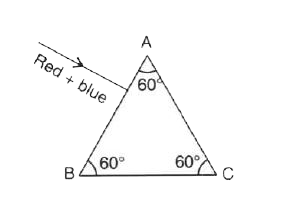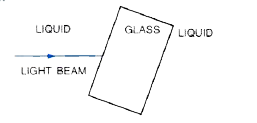The critical angle for glass-air is 45∘ for the light of yellow colour. State whether it will be less than, equal to, or more than 45∘ for (i) red light, and (ii) blue light ?
The correct Answer is:(i) more than 45∘
(ii) less than 45∘.
To determine the critical angle for red and blue light in comparison to the critical angle for yellow light, we can follow these steps:
Step 1: Understand the concept of critical angle
The critical angle is the angle of incidence above which total internal reflection occurs when light travels from a denser medium (like glass) to a less dense medium (like air). The critical angle depends on the refractive index of the materials involved and the wavelength of the light.
Step 2: Recall the relationship between wavelength and refractive index
The refractive index of a medium varies with the wavelength of light. Generally, shorter wavelengths (like blue light) have a higher refractive index compared to longer wavelengths (like red light). This means that as the wavelength decreases, the refractive index increases.
Step 3: Apply the relationship to the critical angle
The critical angle (C) can be calculated using Snell's Law:
sin(C)=n2n1
where n1 is the refractive index of the denser medium (glass) and n2 is the refractive index of the less dense medium (air).
Step 4: Analyze the critical angle for red light
Since red light has a longer wavelength, it has a lower refractive index compared to blue light. Therefore, the critical angle for red light will be greater than that for yellow light (which is given as 45 degrees).
Conclusion for red light:
The critical angle for red light is more than 45 degrees.
Step 5: Analyze the critical angle for blue light
Conversely, blue light has a shorter wavelength, which means it has a higher refractive index. As the refractive index increases, the critical angle decreases. Therefore, the critical angle for blue light will be less than that for yellow light.
Conclusion for blue light:
The critical angle for blue light is less than 45 degrees.
Final Answer:
(i) The critical angle for red light is more than 45 degrees.
(ii) The critical angle for blue light is less than 45 degrees.
---
The critical angle is the angle of incidence above which total internal reflection occurs when light travels from a denser medium (like glass) to a less dense medium (like air). The critical angle depends on the refractive index of the materials involved and the wavelength of the light.
The refractive index of a medium varies with the wavelength of light. Generally, shorter wavelengths (like blue light) have a higher refractive index compared to longer wavelengths (like red light). This means that as the wavelength decreases, the refractive index increases.
The critical angle (C) can be calculated using Snell's Law:
sin(C)=n2n1
where n1 is the refractive index of the denser medium (glass) and n2 is the refractive index of the less dense medium (air).
Since red light has a longer wavelength, it has a lower refractive index compared to blue light. Therefore, the critical angle for red light will be greater than that for yellow light (which is given as 45 degrees).
The critical angle for red light is more than 45 degrees.
Conversely, blue light has a shorter wavelength, which means it has a higher refractive index. As the refractive index increases, the critical angle decreases. Therefore, the critical angle for blue light will be less than that for yellow light.
The critical angle for blue light is less than 45 degrees.
(i) The critical angle for red light is more than 45 degrees.
(ii) The critical angle for blue light is less than 45 degrees.
Topper's Solved these Questions
- REFRACTION OF LIGHT AT PLANE SURFACESBOOK - ICSECHAPTER - REFRACTION OF LIGHT AT PLANE SURFACESEXERCISE - EXERCISE-4(D) MULTIPLE CHOICE TYPE
3 Videos
- REFRACTION OF LIGHT AT PLANE SURFACESBOOK - ICSECHAPTER - REFRACTION OF LIGHT AT PLANE SURFACESEXERCISE - EXERCISE-4(C) NUMERICALS
3 Videos
- REFRACTION OF LIGHTBOOK - ICSECHAPTER - REFRACTION OF LIGHTEXERCISE - DIAGRAM BASED MCQ:
5 Videos
- REFRACTION THROUGH A LENS BOOK - ICSECHAPTER - REFRACTION THROUGH A LENS EXERCISE - EXERCISE-5(D) (MULTIPLE CHOICE TYPE)
2 Videos
Similar Questions
Critical angle of light passing from glass to air is least for
View SolutionThe diagram alongside shows a beam of light (red + blue) incident normally on an equilateral triangular prism. If the critical angle for the material of prüsm is 60∘ for the light of red colour, complete the diagram showing the path of light of each colour emerging out of the prism. Mark in the diagram the angles wherever necessary.

View SolutionWill the focal length of a lens for red light be more, same or less than that for blue light ?
View SolutionThe Brewster angle for the glass air interface is 54.74∘ if a ray of light going from air to glass strikes at an angle of incidence 45∘ then the angle of refraction is
View SolutionThe Brewster angle for the glass air interface is 54.74∘ if a ray of light going from air to glass strikes at an angle of incidence 45∘ then the angle of refraction is
View SolutionIf critical angle for TIR from medium to vacuum is 45 deg then velocity of light in medium
View SolutionWhich light would produce more resolution the red light or the blue one ?
View SolutionName four colours of the spectrum of white light which have wavelength longer than blue light.
View SolutionA machine works as a (i) force multiplier, (ii) speed multiplier. In each case state whether the velocity ratio is more than or less than 1.
View SolutionThe diagram below shows a glass block suspended in a liquid. A beam of light of single colour is incident from liquid on one side of the block.

(a) Draw diagrams to show how does the light bend when it travels from liquid to glass and then to liquid if (i) the light slows down in glass, and (ii) the light speeds up in glass.
(b) State two conditions under which the light ray passing from liquid to glass travels straight without bending. will the glass be visible then ?
View Solution
